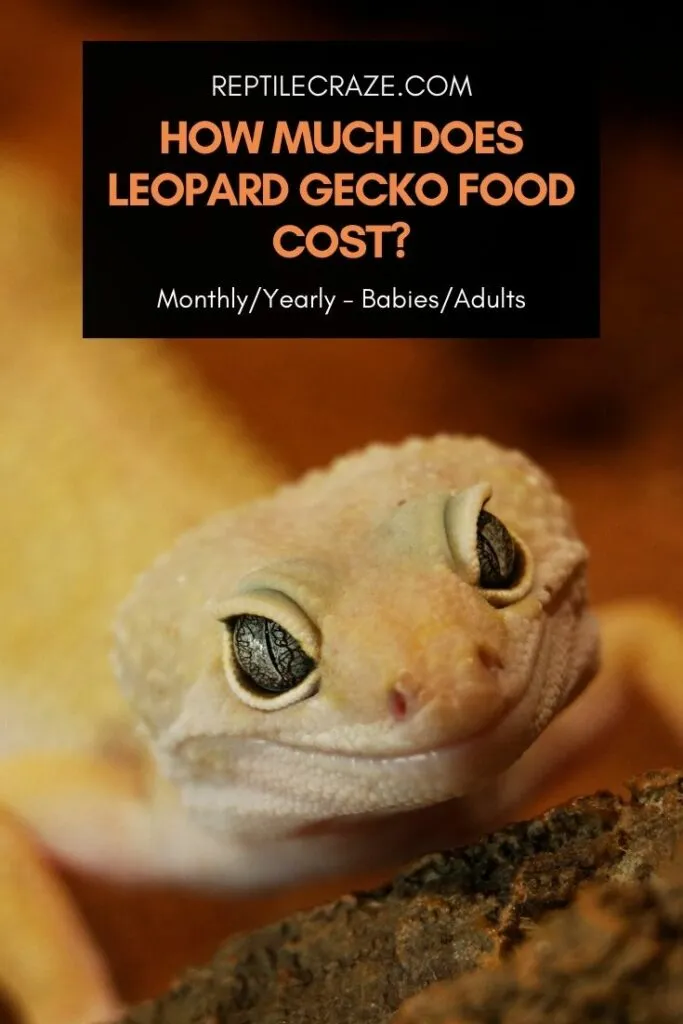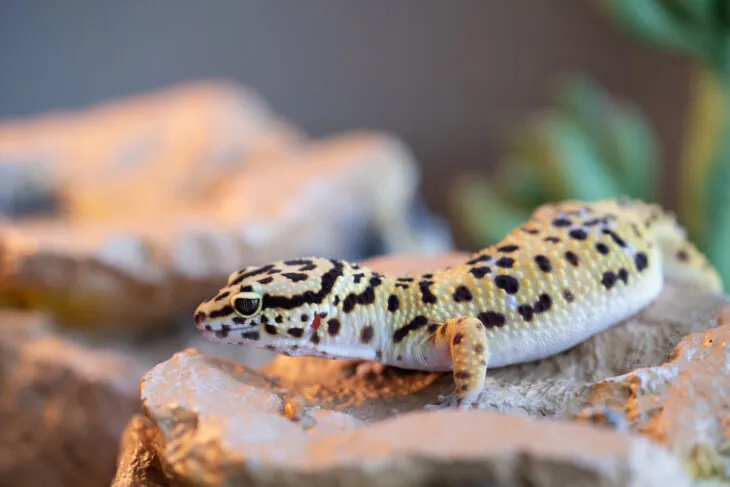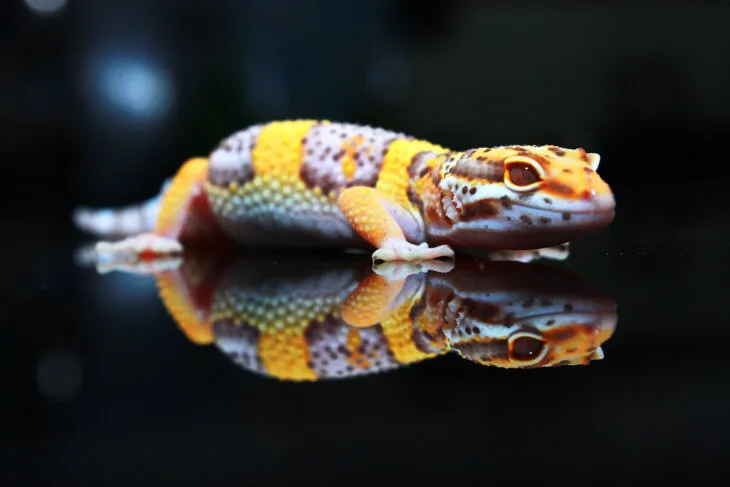
One of the most costly and complex things about keeping a Leopard Gecko is providing the right diet. We all know that Leopard Geckos (Eublepharis macularius) need a varied diet of different insects. This can cause your budget to vary too. So, how much does Leopard Gecko
Feeding an adult Leopard Gecko a varied diet using the cheapest feeder insects amounts to ~$16.50 per month or $198 per year. Including the cost of the most essential supplements, this would total $217.98 per year. Babies cost more to feed, as they can only eat small insects and need more of them.
That’s the basic answer, but let’s get into the math to discover how much it would cost to provide a varied insectivorous diet to your Leopard Gecko.
Table of Contents
Costs Of Common Feeder Insects
In this article, we will be referencing the costs of feeder insects from the popular US supplier, Josh’s Frogs.
The prices are representative of the approximate costs of feeder insects, purchased from a reputable supplier, in the USA. However, there are many suppliers across the US and beyond, that you can choose from.
In the table below, you can see the prices of the smallest possible batch of each type of feeder insect.
Small batches are more likely to be bought by pet owners who only have one or two Leopard Geckos. These feeder insects are all popular options for creating varied Leopard Gecko diets.
Cost Of Small Batches Of Popular Feeder Insects
| Feeder Insect | Batch Size | Cost |
| 1-inch Large Crickets | 60 | $6.99 |
| ¾-inch Standard Mealworms | 100 | $4.99 |
| ¾-inch Large Black soldier fly larvae | 50 | $4.99 |
| 1-inch Large Dubia roaches | 25 | $14.99 |
| Wax worms | 25 | $4.49 |
| Hornworms | 25 | $16.99 |
| ½-inch Medium Silkworms (grow up to 1 ½-inches) | 25 | $14.99 |
From the table, you can see that the most commonly fed staple feeder insects, crickets and mealworms, are by far the most affordable per insect.
Black soldier fly larvae, which have an excellent nutritional profile, are growing in popularity as a staple feeder insect for Leopard Geckos. BSF larvae have a very good calcium to phosphorus ratio. They are also good value for money.
Wax worms are a popular treat for Leopard Geckos, and are low cost. Hornworms and silkworms are arguably much better treats for Leopard Geckos thanks to their better nutritional profile. However, they are also much more expensive.
Dubia roaches, which are also growing in popularity as a staple feeder insect, are still much more expensive than other staple feeders.
But, dubia roaches don’t just live for a matter of weeks like most insects. They can survive for up to 2 years with proper care!
This means that even pet owners who have 1 or 2 Leopard Geckos can take advantage of buying dubia roaches in bulk, for lower prices and reduced expenditure on shipping.
But, this is only useful if you have an adult Leopard Gecko who can eat larger roaches. Unfortunately, the roaches will eventually grow to be up to 2 inches in length, and will need to be wasted when they are too big.

An Example Diet For An Adult Leopard Gecko On A Budget
Here is an example diet for a large, healthy adult Leopard Gecko. The diet is varied, and incorporates some treats. We have chosen the most affordable feeder insects to create this example diet.
| Monday | 4 large crickets | 4 mealworms |
| Wednesday | 6 large crickets (dusted) | 2 wax worms (every other week) |
| Saturday | 4 large crickets (dusted) | 4 mealworms |
What Do You Need To Buy To Feed This Diet For One Month?
14 large crickets X 4 weeks per month = 56 large crickets
2 wax worms X 2 weeks = 4 wax worms
8 mealworms X 4 weeks per month = 32 mealworms
Unfortunately, feeder insects are not sold in such specific numbers. We have costed out the purchase of the smallest batches of feeder insects that you could buy to feed this example diet. But, there will be some wastage if you only have one Leopard Gecko.
Cost Of A Month’s Food For An Adult Leopard Gecko On A Budget
| Feeder Insect | Batch size | Cost |
| 1-inch Large Crickets | 60 | $6.99 |
| Wax worms | 25 | $4.49 |
| Mealworms | 100 | $4.99 |
| Total Cost: | $16.47 |
We have not incorporated the cost of shipping into this calculation. Shipping costs will vary depending on your location. You may be able to avoid shipping costs altogether if you buy from a local store.
Feeding Baby Leopard Geckos Is More Expensive Than Feeding Adults
Take a look at the table below to see how the price per cricket stays almost the same despite the size of the cricket.
Price Comparison By The Size Of The Cricket
| Size of cricket | Batch size | Price |
| 1-inch Large Crickets | 250 | $10.99 |
| ¾ -inch Crickets | 250 | $10.99 |
| ½ -inch Crickets | 250 | $9.99 |
| ¼ -inch Crickets | 250 | $9.99 |
| ⅛ -inch Crickets | 250 | $9.99 |
| Pinhead Crickets | 250 | $9.99 |
Smaller-Sized Crickets Can Only Be Bought In Larger, More Expensive Batches
Smaller crickets cannot be bought in smaller batches. The smallest batch size for the pinhead and ⅛-inch crickets is 250 and costs $9.99. The smallest batch size for large crickets is 60 and costs $6.99.
This means that you are likely to get a lot of
As a result of this wastage, feeding younger Leopard Geckos can be more expensive than adult Leopard Geckos, even though the cost per cricket is almost the same.
For adult Leopard Geckos, you can buy smaller batches of crickets and use them all up. In this way, you get good value for money.
Baby And Juvenile Leopard Geckos Eat A Greater Number Of Insects
Furthermore, baby and juvenile Leopard Geckos eat far more often than adult Leopard Geckos. If a baby Leopard Gecko ate 7 tiny crickets per day, 7 days per week, you would need to feed them 196 crickets per month.
In comparison, if an adult Leopard Gecko ate 7 large crickets, 3 times per week, you would need to feed them 84 crickets per month. As large and small crickets cost almost the same, this means that feeding baby Leopard Geckos is much more expensive.

An Example Diet For A Baby Leopard Gecko On A Budget
Here is an example diet for a baby Leopard Gecko, growing well, under 4 months of age. The diet is varied, but could certainly be more varied.
We have chosen the most affordable feeder insects to create this example diet, that balances high protein with supplementary fat.
| Monday | 5-6 Small crickets (dusted) | 1-2 black soldier fly larvae |
| Tuesday | 5-6 Small crickets (dusted) | |
| Wednesday | 5-6 Small crickets (dusted) | |
| Thursday | 5-6 Small crickets (dusted) | 1-2 black soldier fly larvae |
| Friday | 5-6 Small crickets (dusted) | |
| Saturday | 5-6 Small crickets (dusted) | 1-2 black soldier fly larvae |
| Sunday | 5-6 Small crickets (dusted) |
What Do You Need To Buy To Feed This Diet For One Month?
42 small crickets X 4 weeks per month = 168 small crickets
6 black soldier fly larvae X 4 weeks = 24 black soldier fly larvae
Cost Of A Month’s Food For A Baby Leopard Gecko On A Budget
| Feeder Insect | Batch size | Cost |
| Small Crickets (Buy at the beginning of the month) | 250 | $9.99 |
| Small Crickets (Buy in the middle of the month) | 250 | $9.99 |
| Small Black soldier fly larvae (Buy at the beginning of the month) | 50 | $4.99 |
| Small Black soldier fly larvae (Buy in the middle of the month) | 50 | $4.99 |
| Total Cost: | $29.96 |
We have costed out the purchase of the smallest batches of feeder insects that you could buy to feed this example diet. If you can buy smaller batches, this would help a lot. But, there will still be a massive amount of wastage if you only have one Leopard Gecko.
Unfortunately, this is largely due to the fact that small Leopard Geckos are limited to eating small insects. Eating insects that are too large could cause choking or impaction.
This means that the insects will not be the correct size for long, as they will grow. Black soldier fly larvae can grow from 1mm in length to ¾-inch in length within 2 weeks.
See the table below to understand how fast crickets grow! The insects need to be replaced at least every 2 weeks, or they will outgrow the baby Leopard Gecko.
| Age of Leopard Gecko | Size of cricket | Age of cricket | Category |
| Baby0 – 4 months | Pinhead to ¼ inch | Newborn to 2 weeks | Small |
| Juvenile4 – 10 months | ⅜ to ⅝ inch | 2.5 to 3.5 weeks | Medium |
| Adult10+ months | ¾ to 1 inch | 4 to 4.5 weeks | Large |
Vary Your Leopard Gecko’s Diet When Possible
The above example diets show just one way that you might feed your Leopard Gecko. But, the possibilities are pretty much endless.
Don’t get stuck feeding only the cheapest insects. When you can, try and change them out for others, such as silkworms and dubia roaches.
Dietary variation will keep your Leopard Gecko interested in
Cost Of Supplements For Leopard Geckos
Supplementing your Leopard Gecko’s
You will need to purchase a dusting powder, that is fortified with calcium and vitamin D3 (like this one). You will also need to purchase an insect feed that you can use to gut load your insects.
Depending on what insects you are feeding, you may need multiple products. You also need to buy bug gel to hydrate them.
| Example product | Approximate Price | Approximately how many times to buy per year |
| Calcium Food for Crickets | Around $3 | 2 |
| Fluker’s Cricket Quencher | Around $3 | 4 |
| VetArk Nutrobal Dusting Powder | Around $12 | 1 |
| Total: | $18 -$20 |
Save Money By Buying Feeder Insects In Bulk
If you have more than one Leopard Gecko, you may be able to reduce your costs by buying feeder insects in bulk. Take a look at the table to see how the value per cricket improves if you buy larger batches.
Crickets can survive for up to 8-10 weeks with proper care. So, if you have an adult Leopard Gecko who can eat adult crickets, you may be able to buy larger batches of crickets, and take advantage of the better value.
Buying Crickets In Bulk Is More Affordable
| Feeder Insect | Batch size | Cost |
| 1-inch Large Crickets | 60 | $6.99 |
| 1-inch Large Crickets | 250 | $10.99 |
| 1-inch Large Crickets | 500 | $12.99 |
| 1-inch Large Crickets | 1000 | $19.99 |
Save Money By Providing Good Insect Care
If you buy in bulk, you can make savings. However, in order for this to work, you have to keep the insects alive for as long as possible. The potential lifespan for each type of feeder insect varies a lot.
Most feeder insects need shelter,
However, the needs of each type of feeder insect are different. We have put together an in-depth guide on how to store common feeder insects to maximize their value. Click through to learn the best way to store Leopard Gecko food and make feeder insects last.
- Eastern Rat Snake: Nature’s Pest Control and Fascinating Reptile - September 20, 2024
- Eastern Racer: The Fast and Agile Snake - September 19, 2024
- The Eastern Indigo Snake: The Majestic, Non-Venomous Hunter of the Southeast - September 18, 2024
